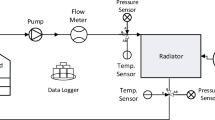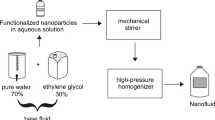Abstract
The cooling performance of a vehicle radiator was experimentally investigated using pure water, graphene oxide (GO) and graphene nano ribon (GNR) nano-fluids in this paper. Three different fluid inlet temperatures (36, 40 and 44 °C) and four different flow rates (0.6, 0.7, 0.8 and 0.9 m3 h−1) were performed in the experiments. GO and GNR nano-fluids were obtained at 0.01 and 0.02% vol. concentrations by means of pure water as a base fluid. In order to determine the heat transfer enhancement, the experimental datas were compared as overall heat transfer coefficients (U) for pure water and nano-fluids. The mean enhancement values of U for all temperatures were obtained as 5.41% and 26.08% for 0.01% and 0.02% vol. concentrations of GO/water nano-fluid and 15.62% and 20.64% for 0.01% and 0.02% vol. concentrations of GNR/water nano-fluid, respectively.









Similar content being viewed by others
Abbreviations
- A:
-
Area (m2)
- cp :
-
Specific heat (J/kg K)
- F:
-
Correction coefficient
- k:
-
Thermal conductivity coefficient (W/mK)
- \( \dot{m} \) :
-
Mass flow rate (m3/h)
- NTU:
-
Number of transfer unit
- q:
-
Heat load (W)
- T:
-
Temperature (°C)
- U:
-
Overall heat transfer coefficient (W/m2K)
- ϕ:
-
Concentration (%)
- ε:
-
Effectiveness
- μ:
-
Viscosity (kg/m2s)
- ρ:
-
Density (kg/m3)
- bf:
-
Base fluid
- f:
-
Fluid
- h,c:
-
Hot and cold fluids
- i,o:
-
Inlet and outlet conditions
- nf:
-
Nano-fluid
- p:
-
Particle
- s:
-
Surface
References
Das SK, Choi SUS, Yu W, Pradeep T (2008) Nanofluids: science and technology. John Wiley & Sons, Inc, Hoboken
Kulkarni DP, Vajjha RS, Das RS, Oliva D (2008) Application of aluminum oxide nanofluids in diesel electric generator as jacket water coolant. Appl Therm Eng 28:1774–1781
Canbolat AS, Türkan B, Yamankaradeniz R, Can M, Etemoğlu AB (2014) Otomobil radyatörlerinde boru sayısının ısıl performansa ve etkenliğe etkisinin incelenmesi. 7th International Automotive Technologies Congress, Bursa
Naraki M, Peyghambarzadeh SM, Hashemabadi SH, Vermahmoudi Y (2013) Parametric study of overall heat transfer coefficient of CuO/water nanofluids in a car radiator. Int Journal of Thermal Sciences 66:82–90
Hong KS, Hong TK, Yang HS (2006) Thermal conductivity of Fe nanofluids depending on the cluster size of nanoparticles. Appl Phys Lett 88:1–3
Hwan L, Hwang K, Janga S, Lee B, Kim J, Choi SUS, Choi C (2008) Effective viscosities and thermal conductivities of aqueous nanofluids containing low volume concentrations of Al2O3 nanoparticles. Int Journal of Heat and Mass Trans 51:2651–2656
Jang SP, Choi SUS (2006) Effects of various parameters on nanofluid thermal conductivity. J Heat Transf 129:617–623
Duangthongsuk W, Wongwises S (2008) Heat transfer enhancement and pressure drop characteristics of TiO2-water nanofluid in a double-tube counter flow heat exchanger. Int Journal of Heat and Mass Transfer 52:2059–2067
Zamzamian A, Oskouie SN, Doosthoseini A, Joneidi A, Pazouki M (2011) Experimental investigation of forced convective heat transfer coefficient in nano-fluids of Al2O3/EG and CuO/EG in a double pipe and plate heat exchangers under turbulent flow. Exp Thermal Fluid Sci 35:95–502
Naphon P, Assadamongkol P, Borirak T (2008) Experimental investigation of titanium nanofluids on the heat pipe thermal efficiency. Int Commun in Heat and Mass Transfer 35:1316–1319
Noie SH, Heris SZ, Kahani M, Nowee SM (2009) Heat transfer enhancement using Al2O3/water nanofluid in a two-phase closed thermosyphon. Int. J. Heat and Fluid Flow 30:700–705
Nguyen CT, Roy G, Gauthier C, Galanis N (2007) Heat transfer enhancement using Al2O3/water nanofluid for an electronic liquid cooling system. Appl Therm Engineering 27:1501–1506
Jung JY, Oh HS, Kwak HY (2009) Forced convective heat transfer of nanofluids in microchannels. Int Journal of Heat and Mass Transfer 52:466–472
Park KJ, Jung D (2007) Boiling heat transfer enhancement with carbon nanotubes for refrigerants used in building air-conditioning. Energy and Builds 39:1061–1064
Kulkarni DP, Das DK, Vajjha RS (2009) Application of nanofluids in heating buildings and reducing pollution. Appl Energy 86:2566–2573
Hussein AM, Bakar RA, Kadirgama K (2014) Study of forced convection nano-fluid heat transfer in the automotive cooling system. Case Studies in Thermal Engineering 2:50–61
Kılınc F, Buyruk E, Karabulut K (2017) An experimental study for heat transfer enhancement of graphene nanoribbon nanofluid in an automobile radiator. 8th International Advanced Technology Symposium, Elazığ
Karabulut K, Yapıcı K, Buyruk E, Kılınc F (2015) Experimental and numerical investıigation of heat transfer enhancement and pressure drop performance of nanofluid containing carbon nanotube. 20th National Turkish Thermal Sciences and Technology Kongress, Balıkesir
Nieh HM, Teng TP, Yu CC (2014) Enhanced heat dissipation of a radiator using oxide nano-coolant. Int Journal of Thermal Science 77:252–261
Naik RG, Mohite AS, Dadi JF (2015) Experimental evaluation of heat transfer rate in automobile cooling system by using nanofluids. ASME 2015 International Mechanical Engineering Congress and Exposition, Texas
Peyghambarzadeh SM, Hashemabadi SH, Naraki M, Vermahmoudi Y (2013) Experimental study of overall heat transfer coefficient ın the application of dilute nanofluids in the car radiator. Appl Therm Eng 52:8–16
Singh V, Joung D, Zhai L, Das S, Khondaker S, Seal S (2012) Graphene based materials: past, present and future. Prog Mater Sci 56:1178–1271
Novoselov K, Geim AK, Morozov S, Jiang D, Grigorieva MKI, Dubonos S, Firsov A (2005) Two-dimensional gas of massless dirac fermions in graphene. Nature 438:197–200
Balandin AA, Ghosh S, Bao W, Calizo I, Teweldebrhan D, Miao F, Lau CN (2008) Superior thermal conductivity of single-layer graphene. Nano Lett 8:902–907
Hajjar Z, Rashidi Z, Ghozatloo Z (2014) Enhanced thermal conductivities of graphene oxide nanofluids. Int Communications In Heat and Mass Transfer 57:128–131
Hummers WS, Offeman RE (1958) Preparation of graphitic oxide. Jou of American Chemistry Society 80:1339–1339
Eravcu F (2016) Karbon tabanlı nanomalzemelerin sentezi, karakterizasyonu, reolojisi, ısıl iletkenliği ve kararlılığı. MSc. Thesis, Cumhuriyet University
Kılınc F (2015) Enhancement of heat transfer performance by using nanofluids in auto radiators. PhD Thesis, Cumhuriyet University
Pak BC, Cho YI (1998) Hydrodynamic and heat transfer study of dispersed fluids with submicron metallic oxide particles. Experimental Heat Transfer 11:151–170
Khanafer K, Vafai K (2011) A critical synthesis of thermophysical characteristics of nano-fluids. Int Journal of Heat and Mass Transfer 54:4410–4428
Incropera FP, DeWitt DP (1996) Fundamentals of heat and mass transfer. Wiley, New York
Holman JP (2001) Experimental methods for engineers, 7th edn. Mcgraw-hill, New York
Subhedar DG, Ramani BM, Gupta A (2018) Experimental investigation of heat transfer potential of Al2O3/water-mono ethylene glycol nanofluids as a car radiator coolant. Case Studies in Thermal Engineering 11:26–34
Jadar R, Shashishekar KS, Manohara SR (2019) Performance evaluation of Al-MWCNT based automobile radiator. Materials Today: Proceedings 9:380–388
Contreras EMC, Oliveira GA, Filho EPB (2019) Experimental analysis of the thermohydraulic performance of graphene and silver nanofluids in automotive cooling systems. Int J Heat Mass Transf 132:375–387
Acknowledgements
This experimental work was supported by Sivas Cumhuriyet University Scientific Research Projects Unit with M-526 project number.
Author information
Authors and Affiliations
Corresponding author
Additional information
Publisher’s note
Springer Nature remains neutral with regard to jurisdictional claims in published maps and institutional affiliations.
Rights and permissions
About this article
Cite this article
Kılınç, F., Buyruk, E. & Karabulut, K. Experimental investigation of cooling performance with graphene based nano-fluids in a vehicle radiator. Heat Mass Transfer 56, 521–530 (2020). https://doi.org/10.1007/s00231-019-02722-x
Received:
Accepted:
Published:
Issue Date:
DOI: https://doi.org/10.1007/s00231-019-02722-x




